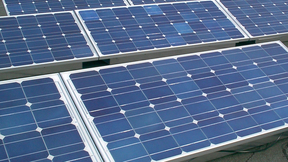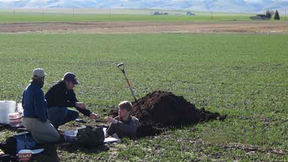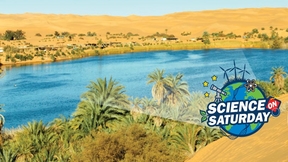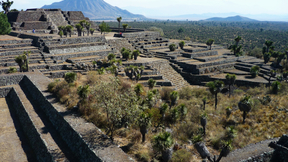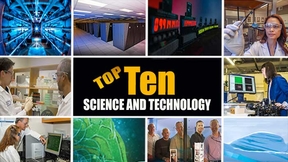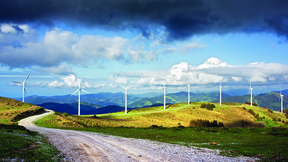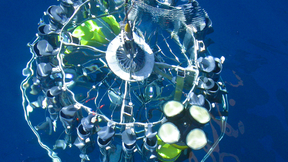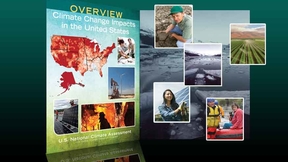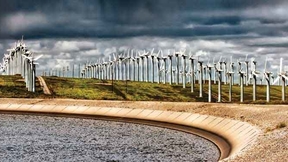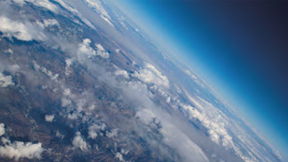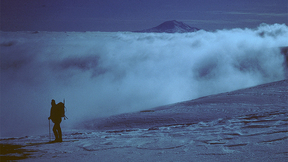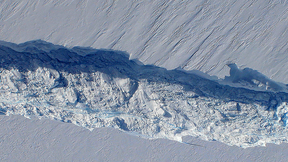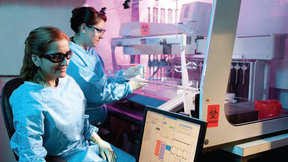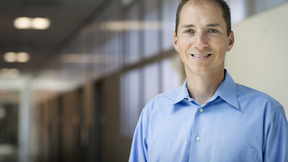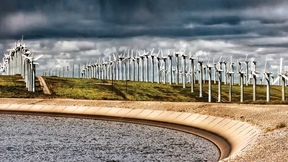Back
Earth and Atmospheric Science
American energy use up slightly, carbon emissions almost unchanged
Americans' energy use continued to grow slowly in 2014, fueled by increases in the use of natural gas, wind and solar, according to the most recent energy flow charts released by Lawrence Livermore National Laboratory.Each year, the Laboratory releases charts that illustrate the nation's consumption and use of energy. Overall, Americans used 0.9 quadrillion (quads) British…
Soil organic matter vulnerable to climate change
Soil organic matter, long thought to be a semi-permanent storehouse for ancient carbon, may be much more vulnerable to climate change than previously thought.Plants direct between 40 percent and 60 percent of photosynthetically fixed carbon to their roots and much of this carbon is secreted and then taken up by root-associated soil microorganisms. Elevated carbon dioxide …
'Science On Saturday' to explore groundwater and the impacts of drought and climate change
Who: Lawrence Livermore scientist Andy Thompson and Tracy High School teacher Erin McKay will present "Hydrology of an ‘Ant Farm’," a presentation examining the environmental impact of drought and climate change.What: This informative and entertaining lecture will touch on groundwater interactions with surface water and surface ecosystems. The presenters will discuss some…
'Science On Saturday' to explore green power
WHO: Lawrence Livermore scientists Jeff Mirocha and Suzanne Singer, along with Las Positas Community College instructor Eric Harpell and Granada High School teacher Tom Shefler, will present "Green Power: Making Electricity Out of Thin Air," the second of four lectures for the Science on Saturday series for students.WHAT: This informative and entertaining lecture will…
Lawrence Livermore research finds early Mesoamericans affected by climate change
Scientists have reconstructed the past climate for the region around Cantona, a large fortified city in highland Mexico, and found the population drastically declined in the past, at least in part because of climate change.The research appears in the online edition of the Proceedings of the National Academy of Sciences for the week of Jan. 26.Lawrence Livermore researcher…
Top 10 science and technology stories of 2014
In 2014, Lawrence Livermore National Laboratory (LLNL) built on a 62-year tradition of translating basic science into technologies that ensure national security, address pressing real world problems and expand the boundaries of fundamental science.The top stories of the year are a reflection of the Laboratory’s ability to apply its core national security competencies to a…
Webinar to present modeling and simulation capabilities critical for wind power industry
Learn more about Lawrence Livermore National Laboratory’s modeling and simulation capabilities critical for the wind power industry during the next monthly installment of the Industrial Partnerships Office (IPO) Technology & Market Discovery Webinar series, on Tuesday, Dec. 9.The presentation by Lab engineer and wind program leader Wayne Miller, titled "Toolkit for the…
Livermore Lab scientists show salinity matters when it comes to sea level changes
LIVERMORE, California -- Using ocean observations and a large suite of climate models, Lawrence Livermore National Laboratory scientists have found that long-term salinity changes have a stronger influence on regional sea level changes than previously thought. "By using long-term observed estimates of ocean salinity and temperature changes across the globe, and contrasting…
California to experience more droughts, wildfires in the future
California will experience increased heat, drought and insect outbreaks and more wildfires, according to a new report released Tuesday by the White House.The National Climate Assessment reportalso explains how California will have to deal with declining water supplies, reduced agricultural yields, health impacts in cities due to heat and flooding and erosion in coastal…
Americans using more energy according to Lawrence Livermore analysis
Americans used more renewable, fossil and even nuclear energy in 2013, according to the most recent energy flow charts released by Lawrence Livermore National Laboratory.Each year, the Laboratory releases energy flow charts that illustrate the nation's consumption and use of energy. Overall, Americans used 2.3 quadrillion thermal units more in 2013 than the previous year…
Science academies explain global warming in 'plain English'
If emissions of greenhouse gases continue in a business-as-usual manner, future changes in climate will substantially exceed those that have occurred so far, with a warming of the Earth in the range of roughly 5 to 9 degrees Fahrenheit by the end of the century. That is the conclusion of a new report by the U.S. National Academy of Sciences (NAS) and The Royal Society,…
Volcanoes contribute to recent warming 'hiatus'
LIVERMORE, Calif. -- Volcanic eruptions in the early part of the 21st century have cooled the planet, according to a study led by Lawrence Livermore National Laboratory. This cooling partly offset the warming produced by greenhouse gases. Despite continuing increases in atmospheric levels of greenhouse gases, and in the total heat content of the ocean, global-mean…
Current ice melt rate in Pine Island Glacier may go on for decades
A study of the Pine Island Glacier could provide insight into the patterns and duration of glacial melt. The Pine Island Glacier, a major outlet of the West Antarctic Ice Sheet, has been undergoing rapid melting and retreating for the past two decades. But new research by an international team including researchers from Lawrence Livermore National Laboratory shows that…
Change in Pacific nitrogen content tied to climate change
Using deep sea corals gathered near the Hawaiian Islands, a Lawrence Livermore scientist, in collaboration with UC Santa Cruz colleagues, has determined that a long-term shift in nitrogen content in the Pacific Ocean has occurred as a result of climate change. Overall nitrogen fixation in the North Pacific Ocean has increased by about 20 percent since the mid 1800s -- a…
LLNL scientists find precipitation, global warming link
The rain in Spain may lie mainly on the plain, but the location and intensity of that rain is changing not only in Spain but around the globe.A new study by Lawrence Livermore National Laboratory scientists shows that observed changes in global (ocean and land) precipitation are directly affected by human activities and cannot be explained by natural variability alone. The…
LLNL wins four tech transfer regional awards
Lawrence Livermore National Laboratory (LLNL) has again received recognition this year for its work to move breakthrough technologies into the commercial marketplace.Livermore researchers and tech transfer professionals garnered four awards in the Federal Laboratory Consortium's (FLC) Far West Regional competition.This year's awards, presented last week during the FLC's…
Former Lawrence Fellow David Lobell receives MacArthur fellowship
Former Lawrence Fellow David Lobell , who has done groundbreaking work on the agricultural impacts of climate change, has received a MacArthur fellowship.He is among 24 individuals honored this year by the John D. and Catherine T. MacArthur Foundation , which recognizes exceptionally creative individuals with a track record of achievement and the potential for even more…
Lawrence Livermore study finds human activity affects vertical structure of atmospheric temperature
Human influences have directly impacted the latitude/altitude pattern of atmospheric temperature. That is the conclusion of a new report by scientists from Lawrence Livermore National Laboratory and six other scientific institutions. The research compares multiple satellite records of atmospheric temperature change with results from a large, multi-model archive of…
Lawrence Livermore engineering team makes breakthrough in solar energy research
LIVERMORE, Calif. - The use of plasmonic black metals could someday provide a pathway to more efficient photovoltaics (PV) -- the use of solar panels containing photovoltaic solar cells -- to improve solar energy harvesting, according to researchers at Lawrence Livermore National Laboratory (LLNL).The LLNL Materials Engineering Division (MED) research team has made…
Americans continue to use more renewable energy sources
Americans used more natural gas, solar panels and wind turbines and less coal to generate electricity in 2012, according to the most recent U.S. energy charts released by Lawrence Livermore National Laboratory . Each year, the Laboratory releases energy flow charts that track the nation's consumption of energy resources. Natural gas use is up particularly in the…


